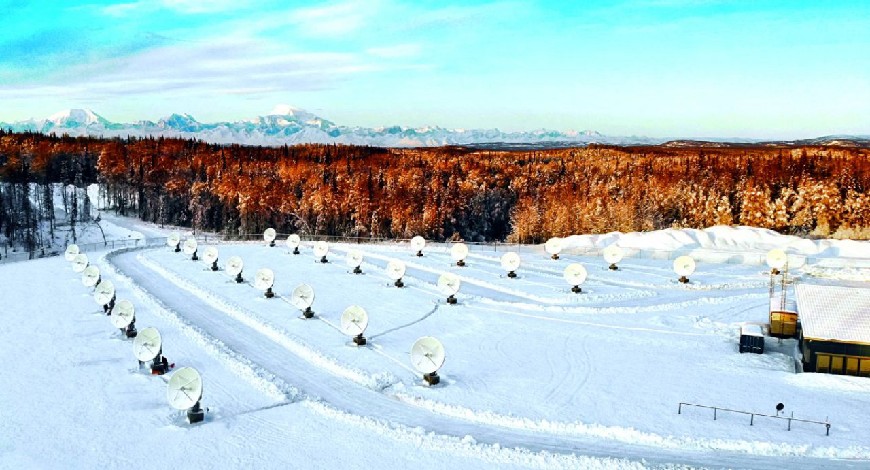Trends
Indirect satellite internet: OneWeb brings Alaskan natives online

The Indian satellite operator OneWeb starts operations with more than 250 satellites. The company in Alaska will bring its first customers to the Internet. There are huge areas there that have never had broadband access. That should change from autumn. The Akiak tribe was the first to build a wireless access network for its members, which is connected to the Internet via OneWeb satellites. OneWeb has to launch more than 400 satellites for global coverage.
OneWeb is technically comparable to SpaceX’s Starlink: Just like Starlink, OneWeb has hundreds of satellites in orbit. They broadcast to ground stations with fiber optic connections on the one hand and to customers who want Internet access on the other. While Starlink satellites are currently whizzing around the earth at an altitude of around 550 kilometers, OneWeb satellites orbit a little further away at around 1200 kilometers. OneWeb therefore needs fewer satellites for the same earth coverage, but has slightly longer signal transit times (latency).
The business model differs more clearly: unlike Starlink, OneWeb does not sell directly to end users, but to wholesalers. And while Starlink builds the ground stations necessary for the connection to the Internet itself, OneWeb relies on partners for this too. In Alaska, these include Pacific Dataport (PDI) and its sister company Microcom. The latter has already set up a OneWeb ground station with 29 satellite terminals and redundant fiber optic connections in Talkeetna, around 180 kilometers north of Anchorage. Further locations are in the works.
Fiber optic satellite radio network and back
But Pacific Dataport does not sell to private customers either, but acts as a middle mile provider for satellite Internet. PDI provides local access network operators with the necessary internet connection and uses OneWeb satellites.
The indigenous people in western Alaska take advantage of this: In the region where the rivers Yukon and Kuskowim flow into the Bering Sea, 56 Indian tribes have come together to form the Yukon Kuskowim Delta Tribal Broadband Consortium. The area is about one and a half times the size of Austria, has no roads and so far has no broadband internet. The Tribal Broadband Consortium has set itself the task of changing the latter.
The natives have secured radio spectrum in the 2.5 GHz band from the federal regulatory authority FCC, and the US Department of Commerce subsidizes the construction of local radio networks in settlements without broadband. The first such fixed wireless network will be built in the village of Akiak this autumn and is scheduled to go into operation in November. Then the approximately 400 inhabitants will be able to use broadband internet for the first time. Those involved have not yet revealed the radio standard chosen for this.
GEO satellite is also coming
Usage volumes of up to 150 GB per month and connection are planned; the price has not yet been determined, but should be affordable for private households. The local radio network is being built by Microcom and will be owned by the local Indian tribe, the Akiak Native Community. The backhaul connection to the Internet is provided by PDI via OneWeb satellites, as PDI Vice President Shawn Williams explained in an interview with heise online. His company plans to bring up to 90 villages online in Alaska over the next two years.
Pacific Dataport will also provide two of its own geostationary satellites for this purpose. The first is called Aurora 4A and is slated to travel to orbit aboard a SpaceX rocket in 200 days. It would then go into operation in March and will offer around 7.5 gigabits of transmission capacity. In mid-2024, Aurora IV, a Very High Throughput Satellite (vHTS) with around 100 Gigabit capacity, is to join. Because the two Aurora satellites are stationed at an altitude of 36,000 kilometers, end customers have to expect latency times of around 600 milliseconds. In return, Internet access should be cheap at 99 US dollars per month (about 84 euros).
PDI will also offer its own satellites in combination with OneWeb. Applications that require short latency times, including computer games, will primarily go online via OneWeb, while data-intensive applications such as video streaming will be served more by the Aurora satellites. Special end customer routers control this form of load balancing automatically. The combination of LEO and GEO satellites combines favorable transmission capacities with short signal transit times. Inmarsat plans to set up a hybrid network with 150-175 of its own LEO and several GEO satellites in the next five years.
The two Aurora satellites Pacific Dataports will cover the whole of Alaska and large parts of Canada: British Columbia, the Yukon, the Northwest Territories and parts of Nunavut and northern Alberta. So the company is considering entering the Canadian market as a middle mile provider. OneWeb’s 250 satellites are already reaching the entire Arctic, but there are hardly any ground stations with fiber optic connections. By the end of next year, 400 satellites are to be added to achieve global coverage. In the subsequent second expansion stage, OneWeb saves 41,000 satellites – it should “only” be 6,372. Market Research Telecast






You must be logged in to post a comment Login